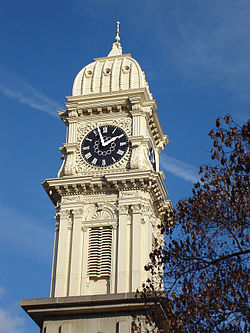- Town Clock (Dubuque)
-
Town Clock Building

Location: 823-25 Main Street, Dubuque, Iowa Coordinates: 42°30′3.93″N 90°40′2.09″W / 42.5010917°N 90.6672472°WCoordinates: 42°30′3.93″N 90°40′2.09″W / 42.5010917°N 90.6672472°W Built: 1873 Architect: Fridolin J. Heer, Edward Naescher, L.T. Farwell Architectural style: Italianate Governing body: Private NRHP Reference#: 01001488 [1] Added to NRHP: January 24, 2002 The Town Clock is a large clock that stands in downtown Dubuque, Iowa. The clock, which is listed on the National Register of Historic Places, has stood over the city for over 130 years. The present clock is the second "Town Clock"; the first collapsed in the 1870s.
Contents
History
The First Town Clock
In 1864, Asa Horr, a Dubuque area Doctor, helped fund the placement of a town clock. George Wood and his wife gave a perpetual lease to the city for the clock to be placed on the John Bell and Company Store building which they owned.
This first clock was placed on top of the store at a cost of $2,000. At the time, the clock was said to be one of the most accurate in the United States. It began operations in November 1864, and everyone who donated more than $25.00 was given a membership in the Dubuque Town Clock Company, which owned the clock.
On May 25, 1872, several people noticed cracks forming in the walls of the store building. Within a few minutes both the clock and the John Bell store collapsed, killing a child and two women who were inside the store at the time.
An investigation into the matter reported that the foundation of the Bell Store was not sufficient to handle the clock's weight, which was nearly 3,500 pounds (1,600 kg). It was also reported that subsequent construction next door was the primary cause of the accident.
The Second Town Clock
The early years
Dubuque soon decided to replace the collapsed Town Clock. Architect Fridolin Heer, Sr., drew plans for the clock and a new building. This new clock cost $5,309.45, and was erected on April 17, 1873.
The new clock was accurate to within two seconds each week. For a number of years, the clock had a mechanical movement. Two employees spent an hour and a half winding cranks that were attached to the weights, which would allow the clock to operate for one week.
The 1920s
In 1923, the Town Clock was almost dismantled when the financial cost of repairs led the city council to decide to remove the clock. However, the council changed their minds when a poll found that a majority of citizens favored keeping and maintaining it.
In 1927, the clock was electrified by Interstate Power Company when a new Seth Thomas movement was placed in the clock. Western Union then synchronized the clock.
Urban Renewal
With the urban renewal trend in the 1970s, the "Your Town Clock Committee" was organized. Their goal was to have the clock moved from the current location at 825 Main Street to the new Town Clock Plaza, which the city council approved. The cost for the move was $70,000, which was raised through donations raised over a 14 month period.
 The clock as seen from the Fourth Street Elevator
The clock as seen from the Fourth Street Elevator
The Durrant Architecture firm of Dubuque designed a pre-caast four-column pedestal that was then placed in the plaza. The actual tower was brought to the site on Feb 12, 1971, and bolted to the pedestal. The faces of the clock were placed at the new location on Feb 16, 1971. Afterwards the cupola was placed at the new site, which completed the move. After the reassembly was complete, the clock stood about 108 feet above the street, which was about two feet taller than at its previous location.
The move helped increase the visibility of the Town Clock, where it now served as the centerpeice at special events held at Town Clock Plaza. Otherwise, most of the traffic had moved out to the west end of the city. Main street had become an office park.
In 1989, concerns were voiced about vibrations made by loud music and dancers possibly causing damage to the pedestal or the clock. The city studied the problem and stated its confidence that the Town Clock was structurally sound.
Recent events
In recent years, Main Street from Fifth street to Ninth street was reopened to automobile traffic after it was determined that the pedestrian plaza no longer was an effective option for the downtown area. This would have left the Town Clock standing in the middle of Main Street, but a small traffic circle was built around the clock. The clock continues to stand as a distinctive Dubuque landmark. Due to the cold it was frozen at 7:33, however it has been operational year round for several years.
In December 2010, the sci-fi/thriller feature film EASTON'S ARTICLE used the Dubuque Town Clock as a key filming location.
Notes
- ^ "National Register Information System". National Register of Historic Places. National Park Service. 2007-01-23. http://nrhp.focus.nps.gov/natreg/docs/All_Data.html.
U.S. National Register of Historic Places Topics Lists by states Alabama • Alaska • Arizona • Arkansas • California • Colorado • Connecticut • Delaware • Florida • Georgia • Hawaii • Idaho • Illinois • Indiana • Iowa • Kansas • Kentucky • Louisiana • Maine • Maryland • Massachusetts • Michigan • Minnesota • Mississippi • Missouri • Montana • Nebraska • Nevada • New Hampshire • New Jersey • New Mexico • New York • North Carolina • North Dakota • Ohio • Oklahoma • Oregon • Pennsylvania • Rhode Island • South Carolina • South Dakota • Tennessee • Texas • Utah • Vermont • Virginia • Washington • West Virginia • Wisconsin • WyomingLists by territories Lists by associated states Other Categories:- Buildings and structures in Dubuque, Iowa
- National Register of Historic Places in Iowa
- Buildings and structures completed in 1873
- Clock towers in the United States
Wikimedia Foundation. 2010.
